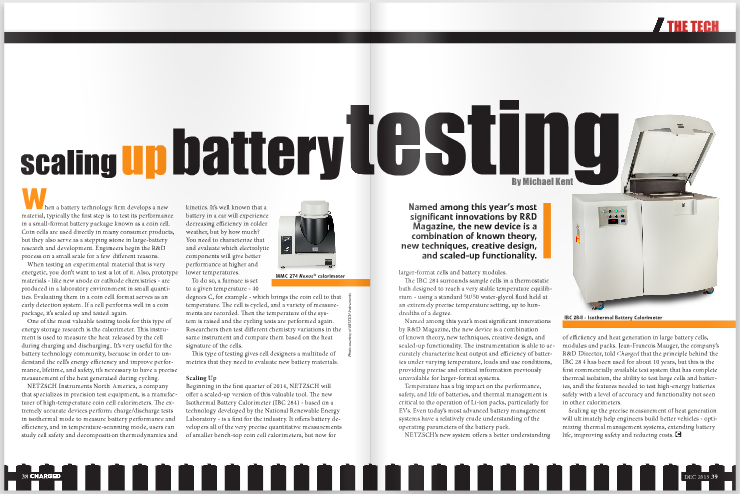When a battery technology firm develops a new material, typically the first step is to test its performance in a small-format battery package known as a coin cell. Coin cells are used directly in many consumer products, but they also serve as a stepping stone in large-battery research and development. Engineers begin the R&D process on a small scale for a few different reasons.
When testing an experimental material that is very energetic, you don’t want to test a lot of it. Also, prototype materials – like new anode or cathode chemistries – are produced in a laboratory environment in small quantities. Evaluating them in a coin cell format serves as an early detection system. If a cell performs well in a coin package, it’s scaled up and tested again.
One of the most valuable testing tools for this type of energy storage research is the calorimeter. This instrument is used to measure the heat released by the cell during charging and discharging. It’s very useful for the battery technology community, because in order to understand the cell’s energy efficiency and improve performance, lifetime, and safety, it’s necessary to have a precise measurement of the heat generated during cycling.


To do so, a furnace is set to a given temperature – 40 degrees C, for example – which brings the coin cell to that temperature. The cell is cycled, and a variety of measurements are recorded. Then the temperature of the system is raised and the cycling tests are performed again. Researchers then test different chemistry variations in the same instrument and compare them based on the heat signature of the cells.
This type of testing gives cell designers a multitude of metrics that they need to evaluate new battery materials.


Beginning in the first quarter of 2014, NETZSCH will offer a scaled-up version of this valuable tool. The new Isothermal Battery Calorimeter (IBC 284) – based on a technology developed by the National Renewable Energy Laboratory – is a first for the industry. It offers battery developers all of the very precise quantitative measurements of smaller bench-top coin cell calorimeters, but now for larger-format cells and battery modules.
The IBC 284 surrounds sample cells in a thermostatic bath designed to reach a very stable temperature equilibrium – using a standard 50/50 water-glycol fluid held at an extremely precise temperature setting, up to hundredths of a degree.


Temperature has a big impact on the performance, safety, and life of batteries, and thermal management is critical to the operation of Li-ion packs, particularly for EVs. Even today’s most advanced battery management systems have a relatively crude understanding of the operating parameters of the battery pack.
NETZSCH’s new system offers a better understanding of efficiency and heat generation in large battery cells, modules and packs. Jean-Francois Mauger, the company’s R&D Director, told Charged that the principle behind the IBC 284 has been used for about 10 years, but this is the first commercially available test system that has complete thermal isolation, the ability to test large cells and batteries, and the features needed to test high-energy batteries safely with a level of accuracy and functionality not seen in other calorimeters.
Scaling up the precise measurement of heat generation will ultimately help engineers build better vehicles – optimizing thermal management systems, extending battery life, improving safety and reducing costs.
This article originally appeared in Charged Issue 11 – DEC 2013



















































